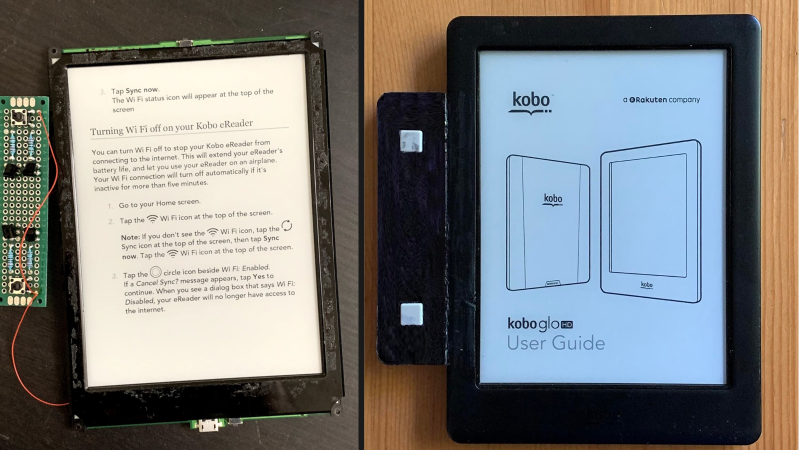Most e-book readers don’t have physical page turn buttons. Why? They just don’t. Virtual page turns are accomplished with a tap at a screen edge. Determined to reduce the awkwardness of one-handed use, [Sagar Vaze] modified a Kobo e-reader with two physical page turn buttons as a weekend project.
[Sagar] points out that since the underlying OS of the Kobo device is Linux, it is possible to fake touches to the screen (and therefore trigger page turns) by recording then replaying the appropriate input event. However, there was a more direct solution available to those willing to tamper slightly with the hardware. Touch sensing on the screen is done via an infrared break-beam system. Along two edges of the screen are IR emitters, and opposite the emitters are receivers. Broadly speaking, when a fingertip touches the display a minimum of two IR beams are broken, and the physical location of the fingertip can therefore be determined by analyzing exactly how the IR pattern has been changed.
To spoof page turns, [Sagar] briefly shorts two IR emitters: one on each axis. The sudden winking out of the IR is interpreted by the device as a crisp tap, and the device obediently turns the page. The only hitch is that both IR emitters must be shorted at the same time. If one is shorted before the other, the device ignores it. Double-pole switches would probably do the trick, but with the part bin coming up empty in that respect, [Sagar] instead used a few transistors to accomplish the same thing. A 3D printed enclosure rounds out the whole mod, and a brief video is embedded below.
What’s nice about this mod is that it requires no high-level interfacing to the device’s OS and and has no effect on the unit’s battery life. By the way, the touch sensing method used by these devices is reminiscent of the detailed look at the zForce AIR touch sensor, shared by our own [Elliot Williams].
















Neonode is a company specializing in this kind of touch sensors. I think the touch sensor in this ereader is made by them. They also made the zForce AIR sensor mentioned at the end (I guess it’s the same as their current AirBar product), which would explain the similarities.
So we could say it’s their fault that ereaders in general are less usable now than when they had buttons?
It’s probably more accurate to blame Kobo designers (not engineers!) who received and subsequently acted on Neonode’s (or whoever’s) marketing. Or maybe you could blame the market that seemingly “favored” such a design, all following those brave revolutionaries who (also) proudly gave us the one-button mouse. Such is life.
who even uses a kobo? I’ve never had a problem swiping one handed with my kindle, I just use my thumb.
I use a Kobo Aura H20 that I’ve had for a few years now. It’s really nice. It’s no problem using a touch or swipe to turn a page on the kobo either. I just prefer having a button I can rest my thumb on and press, instead of moving the thumb to touch the screen, swiping, and waiting for the page to turn.
Sometimes the kindle I have doesn’t register because I didn’t push hard enough, so the process repeats and I get annoyed.
I have and use a Kobo, and love it. That said, I never had any problems page turning one handed, either.
+1: taping or swiping is not a big deal, but sometime I wish I could blow on it to make it turn the page.
But that could make it difficult to read on a windy day!
B^)
Is cigarette smoke IR opaque?
Looks like the hack wrecked a Kobo. I have a Kobo and love it. Easy to tap the screen or swipe to turn a page. Would not want buttons.
I have a Kindle Oasis. You can tap to turn the page or press a button..my favorite Kindle so far. ( this is my third)
I would read ebooks tucked into the covers with the ebook propped up, if you are to leverage all the benefits of ebooks then remote control is important, wired or wireless.
Kudos, I’ll have to remember this if I can’t get something else going (USB Host/Slave, WiFi, Serial, etc) on my Kindle!
I can use my thumb OK to change pages, but I miss my old Kindle Keyboard with its dedicated turn buttons.
It’s not good when every touch/move/swipe/action on a touchscreen does something, and I am starting to suffer from arthritis in my hands which means a touch doesn’t always end up turning the page